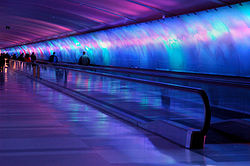Pedestrian: Difference between revisions
m Added category |
|||
| Line 11: | Line 11: | ||
==Health and Environment== |
==Health and Environment== |
||
Regular walking is very important for both a person's [[health]] and the [[natural environment]]. [[Obesity]] and related medical problems can be effectively prevented and/or cured by moving on foot on a daily basis. The widespread habit of taking the car for short |
Regular walking is very important for both a person's [[health]] and the [[natural environment]]. [[Obesity]] and related medical problems can be effectively prevented and/or cured by moving on foot on a daily basis. The widespread habit of taking the car for short trips significantly contributes to both [[obesity]] and climate change, owing to vehicle emissions, as [[internal combustion engine]]s are extremely inefficient and highly polluting during their first minutes of operation (engine cold start). General availability of [[public transportation]] encourages walking, as it won't, in most cases, take one directly to one's destination. |
||
==Roads== |
==Roads== |
||
Revision as of 19:34, 19 September 2006

A pedestrian is a person travelling on foot, whether walking or running. In modern times, the term mostly refers to someone walking on a road or footpath, but this was not the case historically.
History
During the eighteenth and nineteenth centuries, pedestrianism was a popular spectator sport just as equestrianism still is. One of the most famous pedestrians of the day was Captain Robert Barclay Allardice, known as "The Celebrated Pedestrian", of Stonehaven. His most impressive feat was to walk 1 mile every hour for 1000 hours, which he achieved between the 1st of June and the 12th of July, 1809. This feat captured the imagination of the public, and around 10,000 people came to watch over the course of the event. During the rest of the nineteenth century, attempts to repeat this particular athletic challenge were made by many pedestrians including the renowned Ada Anderson who developed it further and walked a quarter-mile in each quarter-hour over the 1,000 hours.
Since the nineteenth century, interest in pedestrianism has dropped. Although it is still an Olympic sport, it fails to catch public attention in the way that it used to. However, pedestrians are still carrying out major walking feats such as the popular Land's End to John o' Groats walk, in the United Kingdom, or traversal of North America from coast to coast. These feats are often tied to charitable fundraising and have been achieved by celebrities such as Sir Jimmy Savile or Ian Botham as well as by people not otherwise in the public eye.
Health and Environment
Regular walking is very important for both a person's health and the natural environment. Obesity and related medical problems can be effectively prevented and/or cured by moving on foot on a daily basis. The widespread habit of taking the car for short trips significantly contributes to both obesity and climate change, owing to vehicle emissions, as internal combustion engines are extremely inefficient and highly polluting during their first minutes of operation (engine cold start). General availability of public transportation encourages walking, as it won't, in most cases, take one directly to one's destination.
Roads

Nowadays, roads often have a designated footpath attached especially for pedestrian traffic, called the sidewalk in American English and the pavement in British English. There are also footpaths not associated with a road which are used purely by pedestrians, particularly ramblers, hikers or hill-walkers and there are roads not associated with a footpath. Such footpaths in mountainous or forested areas are called trails. On some of the latter, pedestrians share the road with horses and vehicles whilst on others they are forbidden from using the road altogether. Also some shopping streets are for pedestrians only. Some roads have special pedestrian crossings. A bridge solely for pedestrians is a footbridge.
Pedestrianisation

Efforts are underway by pedestrian advocacy groups to restore pedestrian access to new developments, especially to counteract newer developments where 20 to 30 percent do not include sidewalks. Some activists advocate large auto-free zones where pedestrians only or pedestrians and some non motorised vehicles are allowed. Many urbanists have extolled the virtues of pedestrian streets in urban areas. Many urban streets in the USA lack street lighting (lamp poles), based on the reasoning that cars have headlights to illuminate their own way. An exception is New York City, the only locality in the United States where more than half of all households do not own a car (the figure is even higher in Manhattan, over 75%; nationally, the rate is 8%[1]). This policy severely restricts or effectively prohibits pedestrian traffic and contributes to excessive car use on short distance trips.
In contrast pedestrian traffic is officially encouraged in some parts of the European Union and construction or separation of dedicated walking routes receives a high priority in most large European city centres, often in conjunction with public transport enhancements. In Copenhagen the world's longest pedestrian shopping area, the Strøget, has been developed over the last 40 years principally due to the work of Danish architect Jan Gehl.
The promotion of walking has been linked to the rebuilding of social capital.
Other uses
The word pedestrian also has a figurative meaning of "unimaginative" or "ordinary." E.g. ‘’She wrote pages and pages of pedestrian prose’’.
